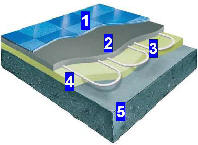|
Cemex Supalo Flowing Screed Composition
Supaflo® is composed of precisely weigh batched calcium sulfate binder and selected aggregates.
The formulation includes sophisticated admixtures, which enhance the plastic properties to aid ease of placing and surface finishing, as well as contributing to improved final hardened properties.
Cemex Supalo Flowing Screed Manufacture
In the UK there is a network of over 40 specialist production units, which cover the vast majority of the country (please check local availability). The addition and mixing of all constituent materials is carried out under precisely controlled conditions to ensure complete dispersion of the mix components.
Cemex Supalo Flowing Screed Compliance & Testing
Supaflo® has been designed to comply with the requirements of:-
• European standard BS EN 13813:2002, Screed material and floor screeds, Screed Material – Properties and Requirements.
• Supaflo® is used to comply with the requirements of the Code of Practice for Floor Screeds, BS 8204: Part 7.
• All constituent materials comply with the relevant British and/or European Standards.
• The Calcium Sulfate used in Supaflo® binders is produced under the stringently controlled conditions of ISO 9001.
• Every load of Supaflo® is tested prior to delivery by CEMEX quality control technicians. An acceptance test is also carried out by the approved contractor before it is pumped. Specially produced flow table equipment is provided for this purpose to each manufacturing unit and to all approved contractors.
Cemex Supalo Flowing Screed Characteristics
• Compaction – The flow characteristics of Supaflo® mean that voids and poor compaction are virtually eliminated. The material self compacts as it flows in to position, giving good resistance to abrasion and impact when compared with conventional screeds. Supaflo®, also complies with the Building Research Establishment Screed Test and indentation requirements of BS 8204.
• Shrinkage – Supaflo® has virtually no drying shrinkage. Movement joints are rarely necessary, however large the floor, as long as the aspect ratio does not exceed approximately 1 to 6 or the total area, about 2000m3. This lack of shrinkage means that differential shrinkage leading to lifting and curling will not occur.
• Fire protection – Supaflo® is non-combustible as defined by BS EN 13501-1.
• Acoustic performance – Supaflo® is far superior to that of conventional screeds. (part E regulations).
• Effect of frost – It is recommended that suitable precautions be taken against frost during cold weather conditions before final strength is achieved.
• Durability – Supaflo® as with virtually all screeds, is not a wearing surface, and requires covering with a suitable surface finish.
• Wet areas – Supaflo® should not be used in areas where it will be continuously wet, or in regular contact with water. It is not recommended for use in communal baths or showers, changing/ washing areas of sports centres, abattoirs, external yards or similar.
Cemex Supalo Flowing Screed Technical Properties
Flow (DIN 1060 test) 240 - 260mm
Plastic density 2060 - 2130kg/m3
BRE impact test less than 2mm
Flexural strength 4 - 6N/mm2
Drying shrinkage less than 0.02%
Time to light foot traffic 1 to 2 days
Drying time at 20ºC and 65% RH 1 day/mm up to 40mm then 2 days/mm
Dry density 1950 - 2050 kg/m3
Fire rating Non combustible
Thermal expansion coefficient mm/mK 0.01 mm/mK
pH 11 - 12
Setting time not less than 3 hours
Cemex Supalo Flowing Screed Thickness and Area
• The high flexural strength of Supaflo® and the lack of voids, means in general it may be laid substantially thinner than conventional materials.
• For instance, in most cases 35mm of Supaflo® will replace 75mm of conventional screed.
• In many cases conventional material will have been specified originally on the basis of a 75mm thickness of conventional cement sand screed.
• If it is replaced by Supaflo® the screed thickness may be reduced and the overall thickness of 75mm made up with appropriate floor grade insulation material. This will provide economies in the usage of screed and will enhance the acoustic and thermal properties. Drying time will also
be significantly reduced allowing the wearing surface to be laid sooner.
• The minimum thickness of application should be as shown in the table below.
Type of construction Minimum application
Thickness (mm)
Unbonded 30
Floating 35
• It is recommended that Supaflo® is laid on a minimum 500-gauge polyethylene de-bonding membrane.
• Supaflo® may be laid in larger bays than traditional floor screeds. Where the approximate shape of the bay is square up to 2000m2 can be achieved. Where the area becomes elongated and approaches an aspect ratio of 1:6 a movement joint should be considered.
Cemex Supalo Flowing Screed Site Work
• Supaflo® is delivered to site ready to use and pumped directly to the point of use; this means that there is no site mixing, only placing.
• A typical pump output can cope with 150m horizontal distances and 60m vertically.
• In practice it takes about 25 ± 5 minutes to pump 5m3 of Supaflo®.
• It is preferable during construction to ensure a steady supply throughout the placement, with no break in continuity that exceeds about one hour.
• Temporary stop ends should be formed where there is a break in supply greater than 1 hour.
• Stop ends can be constructed using timber, scaffold battens, dense concrete blocks or other convenient temporary barriers. They should form a vertical barrier, which can be removed when the next section is placed.
• They should either form a separate but continuous run, without mixing the two areas, or if appropriate use very firm and thorough mixing of the two, to achieve homogeneity.
• It is recommended that the Supaflo® system be treated as debonded and ducts, services and similar are sealed against fluid loss in the flowing system.
• The material should be pump placed onto a prepared membrane, with minimum 5mm compressible plastic strips on all perimeter edges. The membrane may be plastic with taped joints or paper, either heat sealed or taped.
• Underfloor heating may be used 5 days after placing the screed, however the temperature should be increased from ambient by no more than 5ºC a day until full operating temperature is reached.
• Only contractors who are fully trained in its application should lay Supaflo®.
Cemex Supalo Flowing Screed Curing
• Care should be taken to avoid excessive water loss in the first 24 hours.
• Any unglazed or missing windows or doors should be temporarily blocked using plastic sheeting or similar to avoid excessive drying for the first 24 hours.
• After 48 hours, all windows and doors should be opened to allow circulation or de-humidifiers may be used to force dry the material.
• Direct sun must also be avoided during early life.
• Supaflo® may be lightly trafficked after 1 to 2 days, depending on drying conditions.
Cemex Supalo Flowing Screed Hardening and Drying
• The most important consideration when covering Supaflo® is that the material is sufficiently dry for end application.
• For permeable coverings such as carpet a moisture content of less than 1% is required.
• For moisture sensitive coverings such as vinyl, a moisture content of less than 0.5% is required.
• Significant reductions in screed thickness can be achieved by using Supaflo® over conventional screeds in many construction applications, and this in turn will reduce overall drying times.
• Typically, 2 days after installation the screeded rooms must be well ventilated during the day, with doors and windows kept open this will ensure quick drying and rapid strength development.
• Optimum drying time can only take place when warm, moist air is exchanged with cold, dry air, which can absorb moisture again with a rise in temperature.
• Forced air movement using fans can aid the drying process.
• At night when temperatures drop, all doors and windows must be shut to prevent condensation.
• This procedure must be carried out until the screed has dried completely.
Cemex Supalo Flowing Screed Application of Floor Covering
• If the floor covering is to be applied directly to the screed or if the vinyl is thin then the surface of the screed may need sanding or grinding.
• This is usually carried out when the screed is between 3-10 days using a mechanical surface grinder.
• The surface must be free from the ground material before applying the floor finish.
• When bonded floor coverings are applied directly onto Supaflo® it is necessary to prime the screed to regulate suction over the entire area.
• The type of primer used will depend on the chemical make up of the adhesive. In the situations where calcium sulfate based adhesives are used an acrylic, epoxy or similar primer should be applied between the two materials.
• Cementitious adhesives will require the two materials to be separated by an impermeable layer, which would be a polymeric sealer.
|






